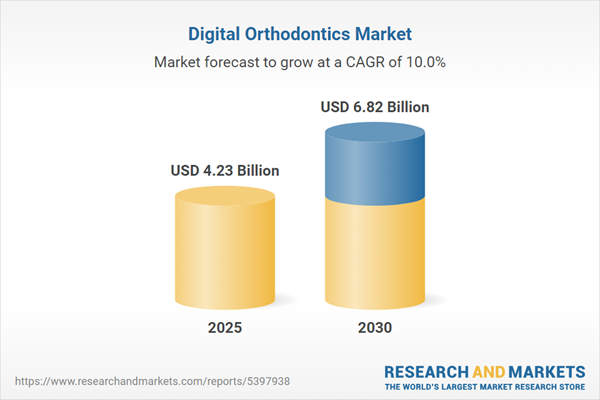Digital Orthodontics is leveraging traditional orthodontics in digital ways. The approach entails the facilitation of aesthetic braces for adults and children in a much quicker and more accurate way through the use of new technologies in orthodontics. It also helps orthodontists in digitalizing treatment and formulating and executing the treatment plan.
In recent times, these digital dental treatments have shown improvement and helped dentists deal with patients in a much shorter timeframe. Digital orthodontics allows orthodontists to take in-house measurements around clear aligners, wires, and retainers via intra-oral digital appliances. The CAD/CAM methodologies and technologies have gradually found their way to orthodontic practices due to the use of the technologies in making individualized wires and plastic trays for patients.
Moreover, emerging trends of adoption and increasing application of digital tools are likely to boost the growth in the digital orthodontics industry. In addition, the growth of available digital orthodontic solutions companies is adding to the attractiveness of the already existing market. Increasing competition and emerging market opportunities are expected to boost the digital orthodontics market growth. Besides, shorter turn-around time, cost, and convenience of digital orthodontics are forecasted to increase demand.
Digital orthodontics market drivers
Rising use of AI and ML is contributing to the digital orthodontics market growth
Integrating artificial intelligence (AI) and machine learning (ML) has enabled medical practitioners to improve treatment planning processes and outcomes. There is also a growing trend in the markets towards the application of digital devices in diagnosis and treatment, including the use of artificial intelligence and machine learning. AI is progressing rapidly in orthodontic treatment procedures due to the evolution of intelligence and the development of corresponding technologies. This leads to the creation of accurate 3-D models of a patient’s dentition with the help of AI and ML tools through scans, X-rays, and other relevant data, dramatically increasing the probability of successful treatment.Moreover, the increase in demand for model-generation practices that are more efficient and accurate is facilitating the wide-scale adoption of AI and ML technologies in orthodontia. In addition, there has been a global increase in expenditure on digital technologies and 3D-printed tailor-made invisible aligner braces.
Digital orthodontics market geographical outlook
North America is witnessing exponential growth during the forecast period
During the forecast period, the North American region is expected to hold a significant market share. The rising adoption of advanced technological solutions in the region, like oral scanners, 3D printing, etc., is projected to fuel the digital orthodontics market growth. Moreover, the rising investments in the region and the entry of several new market players and start-ups are predicted to further propel the market during the assessed period. Furthermore, Asia Pacific is also projected to grow rapidly due to the increasing need for digital orthodontics solutions in developing nations such as India and China.Reasons for buying this report::
- Insightful Analysis: Gain detailed market insights covering major as well as emerging geographical regions, focusing on customer segments, government policies and socio-economic factors, consumer preferences, industry verticals, other sub- segments.
- Competitive Landscape: Understand the strategic maneuvers employed by key players globally to understand possible market penetration with the correct strategy.
- Market Drivers & Future Trends: Explore the dynamic factors and pivotal market trends and how they will shape up future market developments.
- Actionable Recommendations: Utilize the insights to exercise strategic decision to uncover new business streams and revenues in a dynamic environment.
- Caters to a Wide Audience: Beneficial and cost-effective for startups, research institutions, consultants, SMEs, and large enterprises.
What do businesses use our reports for?
Industry and Market Insights, Opportunity Assessment, Product Demand Forecasting, Market Entry Strategy, Geographical Expansion, Capital Investment Decisions, Regulatory Framework & Implications, New Product Development, Competitive IntelligenceReport Coverage:
- Historical data & forecasts from 2022 to 2029
- Growth Opportunities, Challenges, Supply Chain Outlook, Regulatory Framework, Customer Behaviour, and Trend Analysis
- Competitive Positioning, Strategies, and Market Share Analysis
- Revenue Growth and Forecast Assessment of segments and regions including countries
- Company Profiling (Strategies, Products, Financial Information, and Key Developments among others)
The Digital orthodontics market is segmented and analyzed as follows:
By Product
- Intraoral Scanners
- Digital Photography
- 3D Printers
- Computer-Aided Design/ Computer-Aided Manufacturing
By End-Users
- Hospitals
- Clinics
- Research Institutes
- Others
By Geography
- North America
- USA
- Canada
- Mexico
- South America
- Brazil
- Argentina
- Others
- Europe
- Germany
- France
- UK
- Spain
- Others
- Middle East and Africa
- Saudi Arabia
- UAE
- Israel
- Others
- Asia Pacific
- China
- Japan
- India
- South Korea
- Indonesia
- Taiwan
- Others
Table of Contents
Companies Mentioned
- 3M
- Dentsply Sirona
- Stratasys Ltd.
- 3Shape
- Altem Technologies (P) Ltd
- Align Technology, Inc
- Carestream Health
- Planmeca Oy
- Angelalign Technology
- Dentaurum
- Ormco
- Deltaface
- CADdent
- Boss Orthodontics
- FN Orthodontics
Table Information
| Report Attribute | Details |
|---|---|
| No. of Pages | 130 |
| Published | November 2024 |
| Forecast Period | 2025 - 2030 |
| Estimated Market Value ( USD | $ 4.23 Billion |
| Forecasted Market Value ( USD | $ 6.82 Billion |
| Compound Annual Growth Rate | 10.0% |
| Regions Covered | Global |
| No. of Companies Mentioned | 15 |









